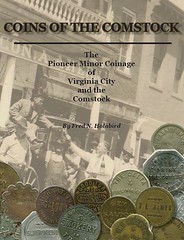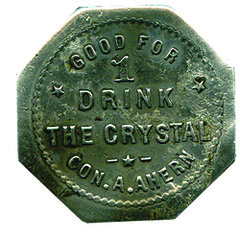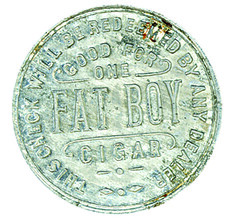
PREV ARTICLE
NEXT ARTICLE
FULL ISSUE
PREV FULL ISSUE
BOOK REVIEW: COINS OF THE COMSTOCK BY FRED HOLABIRD Fred Holabird kindly sent me a printout of his newest book, Coins of the Comstock - The Pioneer Minor Coinage of Virginia City and the Comstock. It's a very readable and well illustrated 90-page book. The tokens and ingots produced by Virginia City, Nevada area merchants are shown in color alongside contemporary black and white photos of the town and its businesses. It has a four-page index listing merchants and topics alphabetically. Fred Holabird kindly sent me a printout of his newest book, Coins of the Comstock - The Pioneer Minor Coinage of Virginia City and the Comstock. It's a very readable and well illustrated 90-page book. The tokens and ingots produced by Virginia City, Nevada area merchants are shown in color alongside contemporary black and white photos of the town and its businesses. It has a four-page index listing merchants and topics alphabetically.The book's Introduction sets the stage with a short discussion of the Comstock Lode, "one of the greatest and largest ore deposits ever discovered". People from all over the world came to California and Nevada to seek their fortunes, find stable and better paying jobs and improve their way of life. With people came the need for money. Without it, people traded in the local commodity - gold. Coinage of all denominations was needed, but not provided. So the merchants had their own made. This book tells part of the story about the west's need for pocket change, and how people, merchants and the Federal Government adapted to meet those needs. The chapters on Virginia City merchants who used pioneer minor coinage help bring to life the companies and people of the period. Call me a purist, but I'm in the camp of those who would object to Fred's use of the word "coin" in reference to these pieces. He addresses this choice on page 2: The terms "coin" and token can be used interchangeably. Some purists consider a coin an item of government issue. This is a new age definition. In a review of five major dictionaries, including Oxford, Webster and Encyclopedia Britannica, only two of these references include the government tie to the word. Regardless of the reader's opinion about the use of the term "token", the book remains a wealth of information about a previously obscure topic. Fred has dug into original source materials such as city directories, contemporary newspapers and historical society photo archives to compile a handy one-stop guide to the history behind the issuers of these rare and interesting souvenirs of the Old West. (There - I wrote "souvenirs", not "tokens", though it pained me to do so...)  Fred notes that while books exist on tokens from each of the western states, few of them list verifiable dates of issue. In a footnote he mentions Russ Rulau's book United States Trade Tokens, 1700-1900 but notes information on the western pieces was lacking at the time it was printed. His research helps narrow down specific timeframes for the issuance of the tokens, which he divided into pre- and post-1900 periods. Fred notes that while books exist on tokens from each of the western states, few of them list verifiable dates of issue. In a footnote he mentions Russ Rulau's book United States Trade Tokens, 1700-1900 but notes information on the western pieces was lacking at the time it was printed. His research helps narrow down specific timeframes for the issuance of the tokens, which he divided into pre- and post-1900 periods.Other sections of the book's Introduction introduce the reader to key collecting aspects such as shapes, sizes, denominations, condition and popular collecting areas and categories including saloon tokens, ghost towns, billiards and pool tokens, cigar store tokens, pictorial pieces, Indian trader tokens, military tokens and water tokens. The remainder of the book is divided into city listings - Virginia City, Gold Hill, Silver City and Jumbo. City listings are further divided as needed into individual businesses and in some cases divided yet again by proprietors of the business. Even in today's Internet age, compiling this information is a lengthy and painstaking process, and the results are neatly displayed here in a Proprietor Chronology for each token. Some of the illustrations can be hard to read, but this is due to the extreme rarity of some of the pieces - high grade pieces are often unobtainable or just don't exist. In many cases, the only surviving examples were dug from the ground in ghost towns. The Klaus and Sazerac Saloon tokens on page 36 and 37 are typical examples of these. Thankfully I can report that most of the illustrations are quite usable.  It's easy for those unfamiliar with the series to dismiss these important numismatic items. As is often the case in numismatics, these artifacts are the only tangible record of the existence of the issuing establishment, and most are quite rare today. For example, less than ten examples of the Fat Boy Cigar token are recorded, and the One Shave token illustrated on p70 is unique. It's easy for those unfamiliar with the series to dismiss these important numismatic items. As is often the case in numismatics, these artifacts are the only tangible record of the existence of the issuing establishment, and most are quite rare today. For example, less than ten examples of the Fat Boy Cigar token are recorded, and the One Shave token illustrated on p70 is unique. Other than the token vs coin question my quibbles with the book are minor. I noted a few typos (such as "exsists" on p50, "Van Ryzn" instead of "Van Ryzin" in a page 6 footnote, and a stray comma in the name of James King of William on page 79). Other than the token vs coin question my quibbles with the book are minor. I noted a few typos (such as "exsists" on p50, "Van Ryzn" instead of "Van Ryzin" in a page 6 footnote, and a stray comma in the name of James King of William on page 79). Coins of the Comstock is a well researched and presented book, a nice addition to the literature of American numismatics, and available at an unbeatable price. Fred tells me the book will be available at the ANA in Los Angeles for a special price of $5, or $20 for his Saloon token book together with Coins of the Comstock. Wayne Homren, Editor The Numismatic Bibliomania Society is a non-profit organization promoting numismatic literature. See our web site at coinbooks.org. To submit items for publication in The E-Sylum, write to the Editor at this address: whomren@gmail.com To subscribe go to: https://my.binhost.com/lists/listinfo/esylum All Rights Reserved. NBS Home Page Contact the NBS webmaster 
|